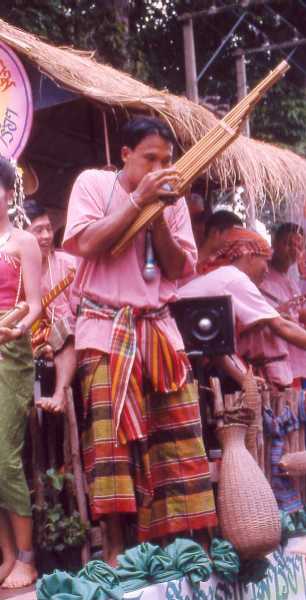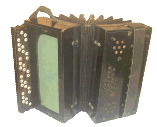Related Research Articles

A concertina is a free-reed musical instrument, like the various accordions and the harmonica. It consists of expanding and contracting bellows, with buttons usually on both ends, unlike accordion buttons, which are on the front.

The Great Exhibition of the Works of Industry of All Nations, also known as the Great Exhibition or the Crystal Palace Exhibition, was an international exhibition that took place in Hyde Park, London, from 1 May to 15 October 1851. It was the first in a series of world's fairs, exhibitions of culture and industry that became popular in the 19th century. The event was organised by Henry Cole and Prince Albert, husband of Victoria, Queen of the United Kingdom.

I. G. Farbenindustrie AG, commonly known as IG Farben, was a German chemical and pharmaceutical conglomerate. It was formed in 1925 by merging six chemical companies later known as BASF Aktiengesellschaft, Bayer AG, Hoechst Aktiengesellschaft, Agfa-Gevaert Group, and Cassella AG. The conglomerate was seized by the Allies after World War II and split into its constituent companies; parts in East Germany were nationalized.

Industrial policy is government policy to encourage the development and growth of all or part of the economy in pursuit of some public goal. Historically, it has often focused on the manufacturing sector, militarily important sectors, or on fostering an advantage in new technologies. In industrial policy, the government takes measures "aimed at improving the competitiveness and capabilities of domestic firms and promoting structural transformation". A country's infrastructure is a major enabler of industrial policy.

The khaen is a Lao mouth organ whose pipes, which are usually made of bamboo, are connected with a small, hollowed-out hardwood reservoir into which air is blown. The khene is the national instrument of Laos. The khene music is an integral part of Lao life that promotes family and social cohesion and it was inscribed in 2017 on the UNESCO Representative List of the Intangible Cultural Heritage of Humanity. It is used among the ethnic Lao Isan and Some tai ethnic groups such as Tai dam In north Vietnam and Lao population of the province of Stung Treng and is used in lakhon ken, a Cambodian dance drama genre that features the khene as the main instrument In Vietnam, this instrument is used among the Tai peoples and the Muong people.

The bandoneon or bandonion is a type of concertina particularly popular in Argentina and Uruguay. It is a typical instrument in most tango ensembles. As with other members of the concertina family, it is held between the hands, and played by pulling and pushing air through bellows, routing it through sets of tuned metal reeds by pressing the instrument's buttons. Unlike most accordions, bandoneons always employ the same sets of reeds to produce their sound, and do not usually have the register switches common on accordions. Nevertheless, the bandoneon can be played very expressively, using various bellows pressures and other techniques. The left and right hand have different timbres due to the wooden box on the left side which gives the left hand a nasal and muted timbre, in contrast with the right hand which is usually bright and sharp.

The English concertina is a member of the concertina family of free-reed musical instruments. Invented in England in 1829, it was the first instrument of what would become the concertina family.

A Chemnitzer concertina is a musical instrument of the hand-held bellows-driven free-reed category, sometimes called squeezeboxes. The Chemnitzer concertina is most closely related to the bandoneón, and more distantly, to the other types of concertinas and accordions. It's essentially a bigger version of the Anglo Concertina that sounds more akin to an Accordion due to having Multiple Ranks of Reeds.

A Schrammel accordion is an accordion with a melody keyboard in the chromatic B-Griff system and a twelve-button diatonic bass keyboard. It is named for a traditional combination of two violins, accordion or clarinet, and contraguitar known as a Schrammelquartet – a group that played Schrammelmusik in the Vienna chamber music tradition.

Noel Hill is an Irish concertina player from County Clare who has had great influence developing the modern playing style of the Irish concertina, as a performer and educator.

Irish traditional music is a genre of folk music that developed in Ireland.

John J. Kimmel was a German-American musician known for playing Irish, Scottish, and American music on the 1-row diatonic accordion. Though not Irish-American, but rather German-American, Kimmel's playing had an enduring effect on the playing of the Irish accordion.

William Henry Wilkins (1860–1905) was an English writer, best known as a royal biographer and campaigner for immigration controls. He used the pseudonym W. H. de Winton.

The Anglo or Anglo-German concertina is a member of the concertina family of free-reed instruments.

The Duet concertina is a family of concertinas, distinguished by being unisonoric and by having their lower notes on the left and higher on the right.

Lachenal & Co. was a British firm producing concertinas from approximately 1850–1936. The firm was founded by Louis L. Lachenal, a Swiss emigrant to the United Kingdom, who arrived there in 1839, and by 1844 was working in support of the famous Wheatstone concertina firm before founding a supporting contract firm and by 1858, an independent firm.

Carl Friedrich Uhlig (1789–1874) was a German luthier, known for inventing the German family of concertinas, from which are descended variants such as the Anglo concertina, bandoneón, Carlsfelder concertina, and Chemnitzer concertina.

Japie Laubscher (1919–1981) was a concertina player of Boeremusiek in South Africa. Per Denis-Constant Martin: "[he] used a singular kind of tremolo, akin to the characteristic vibrato of langarm saxophonists that, according to Vincent Kolbe, may originate in the fiddle traditions of Cape Town ".

Paddy Murphy (1913-1992) is regarded as a founding father of modern Irish concertina music.

John Hill Maccann, or Professor Maccann was a concertina player and designer from Plymouth, England. In 1884, Maccann patented a new design of Duet concertina, which became the first successful and most widely accepted layout of that instrument. Maccann's layout was a refinement of the earlier "Duette" system developed by Charles Wheatstone, inventor of the concertina. Initially called the "New Chromatic Duet English Concertina", it was to later be called simply the "Maccann system".
References
- 1 2 Dan Michael Worrall (1 January 2009). The Anglo-German Concertina: A Social History. Dan Michael Worrall. pp. 1–. ISBN 978-0-9825996-0-0.
- ↑ Tango: Geschichte und Geschichten. Deutscher Taschenbuch. 1999. p. 74. ISBN 978-3-423-24182-3.
- ↑ Official Catalogue of the New-York Exhibition of the Industry of All Nations. 1853. G.P. Putnam & Company. 1853. pp. 140–.